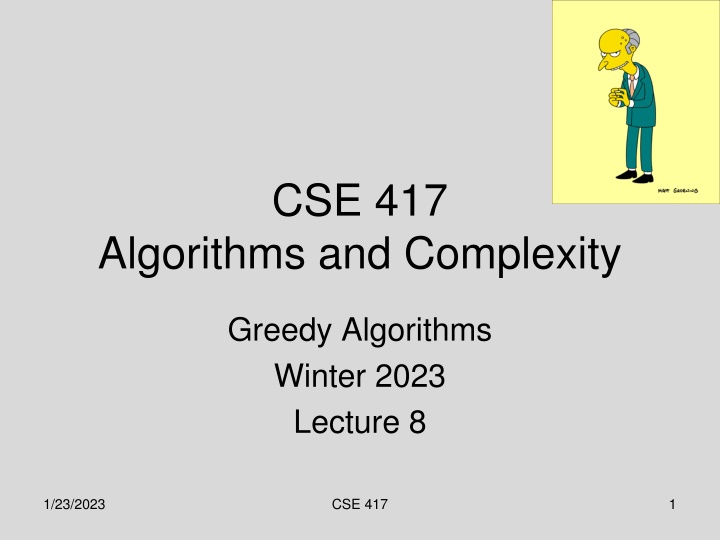
Greedy Algorithms for Scheduling Theory in CSE 417
Dive into the concepts of Greedy Algorithms and Scheduling Theory in CSE 417. Explore topics like Interval Scheduling, Topological Sort Algorithm, and the application of Greedy Algorithms for task scheduling. Enhance your understanding with examples and simulations to solve complex scheduling problems efficiently.
Uploaded on | 1 Views
Download Presentation

Please find below an Image/Link to download the presentation.
The content on the website is provided AS IS for your information and personal use only. It may not be sold, licensed, or shared on other websites without obtaining consent from the author. If you encounter any issues during the download, it is possible that the publisher has removed the file from their server.
You are allowed to download the files provided on this website for personal or commercial use, subject to the condition that they are used lawfully. All files are the property of their respective owners.
The content on the website is provided AS IS for your information and personal use only. It may not be sold, licensed, or shared on other websites without obtaining consent from the author.
E N D
Presentation Transcript
CSE 417 Algorithms and Complexity Greedy Algorithms Winter 2023 Lecture 8 1/23/2023 CSE 417 1
Announcements Reading For today, sections 4.1, 4.2, For next week sections 4.4, 4.5, 4.7, 4.8 Homework 3 is available Random Graphs 1/23/2023 CSE 417 2
Highlight from last lecture: Topological Sort Algorithm While there exists a vertex v with in-degree 0 Output vertex v Delete the vertex v and all out going edges 1 4 3 H E I 2 A 6 5 12 D G J 7 C 9 10 F 8 K B 1/23/2023 CSE 417 3 11 L
Greedy Algorithms Solve problems with the simplest possible algorithm The hard part: showing that something simple actually works Pseudo-definition An algorithm is Greedy if it builds its solution by adding elements one at a time using a simple rule 1/23/2023 CSE 417 4
Scheduling Theory Tasks Processing requirements, release times, deadlines Processors Precedence constraints Objective function Jobs scheduled, lateness, total execution time 1/23/2023 CSE 417 5
Interval Scheduling Tasks occur at fixed times Single processor Maximize number of tasks completed Tasks {1, 2, . . . N} Start and finish times: s(i), f(i) 1/23/2023 CSE 417 6
What is the largest solution? 1/23/2023 CSE 417 7
Greedy Algorithm for Scheduling Let T be the set of tasks, construct a set of independent tasks I, A is the rule determining the greedy algorithm I = { } While (T is not empty) Select a task t from T by a rule A Add t to I Remove t and all tasks incompatible with t from T 1/23/2023 CSE 417 8
Simulate the greedy algorithm for each of these heuristics Schedule earliest starting task Schedule shortest available task Schedule task with fewest conflicting tasks 9
Greedy solution based on earliest finishing time Example 1 Example 2 Example 3 10
Theorem: Earliest Finish Algorithm is Optimal Key idea: Earliest Finish Algorithm stays ahead Let A = {i1, . . ., ik} be the set of tasks found by EFA in increasing order of finish times Let B = {j1, . . ., jm} be the set of tasks found by a different algorithm in increasing order of finish times Show that for r min(k, m), f(ir) f(jr) 1/23/2023 CSE 417 11
Stay ahead lemma A always stays ahead of B, f(ir) f(jr) Induction argument f(i1) f(j1) If f(ir-1) f(jr-1) then f(ir) f(jr) 1/23/2023 CSE 417 12
Completing the proof Let A = {i1, . . ., ik} be the set of tasks found by EFA in increasing order of finish times Let O = {j1, . . ., jm} be the set of tasks found by an optimal algorithm in increasing order of finish times If k < m, then the Earliest Finish Algorithm stopped before it ran out of tasks 1/23/2023 CSE 417 13
Scheduling all intervals Minimize number of processors to schedule all intervals 1/23/2023 CSE 417 14
How many processors are needed for this example?
Prove that you cannot schedule this set of intervals with two processors 1/23/2023 CSE 417 16
Depth: maximum number of intervals active 1/23/2023 CSE 417 17
Algorithm Sort by start times Suppose maximum depth is d, create d slots Schedule items in increasing order, assign each item to an open slot Correctness proof: When we reach an item, we always have an open slot 1/23/2023 CSE 417 18
Greedy Graph Coloring Theorem: An undirected graph with maximum degree K can be colored with K+1 colors
Coloring Algorithm, Version 1 Let k be the largest vertex degree Choose k+1 colors for each vertex v Color[v] = uncolored for each vertex v Let c be a color not used in N[v] Color[v] = c 1/23/2023 20
Coloring Algorithm, Version 2 for each vertex v Color[v] = uncolored for each vertex v Let c be the smallest color not used in N[v] Color[v] = c 1/23/2023 21
Scheduling tasks Each task has a length ti and a deadline di All tasks are available at the start One task may be worked on at a time All tasks must be completed Goal minimize maximum lateness Lateness = fi di if fi di 1/23/2023 CSE 417 22
Example Time Deadline 2 2 4 3 Lateness 1 2 3 Lateness 3 3 2 1/23/2023 CSE 417 23
Determine the minimum lateness Time Deadline 6 2 4 3 4 5 12 5 1/23/2023 CSE 417 24
